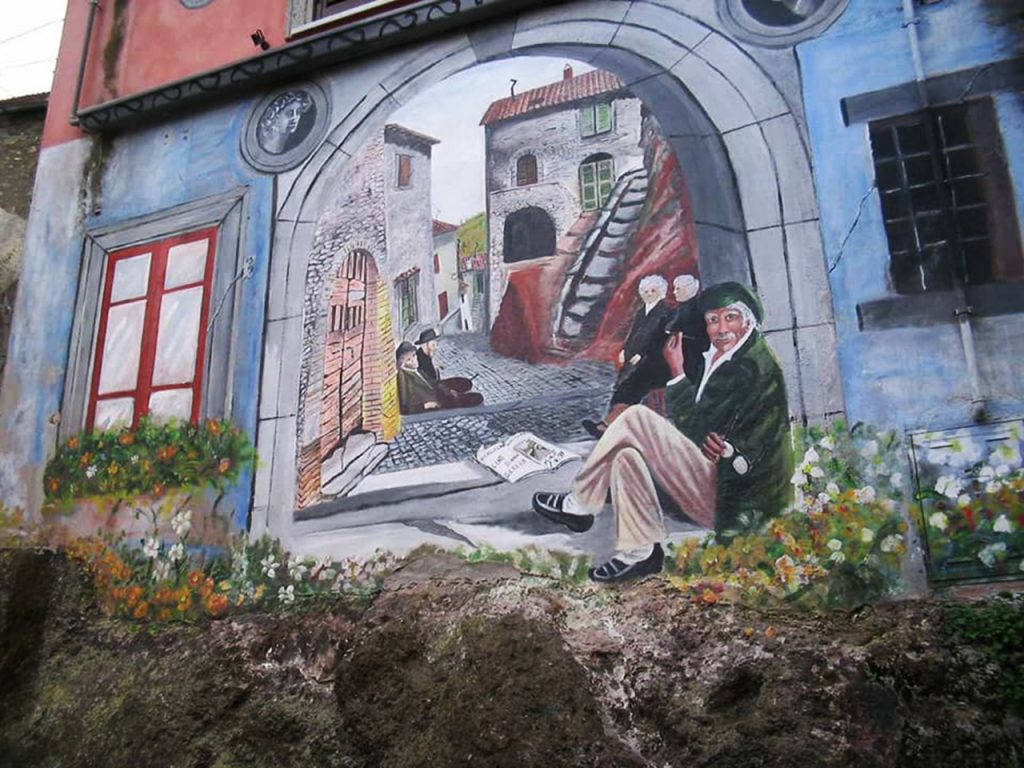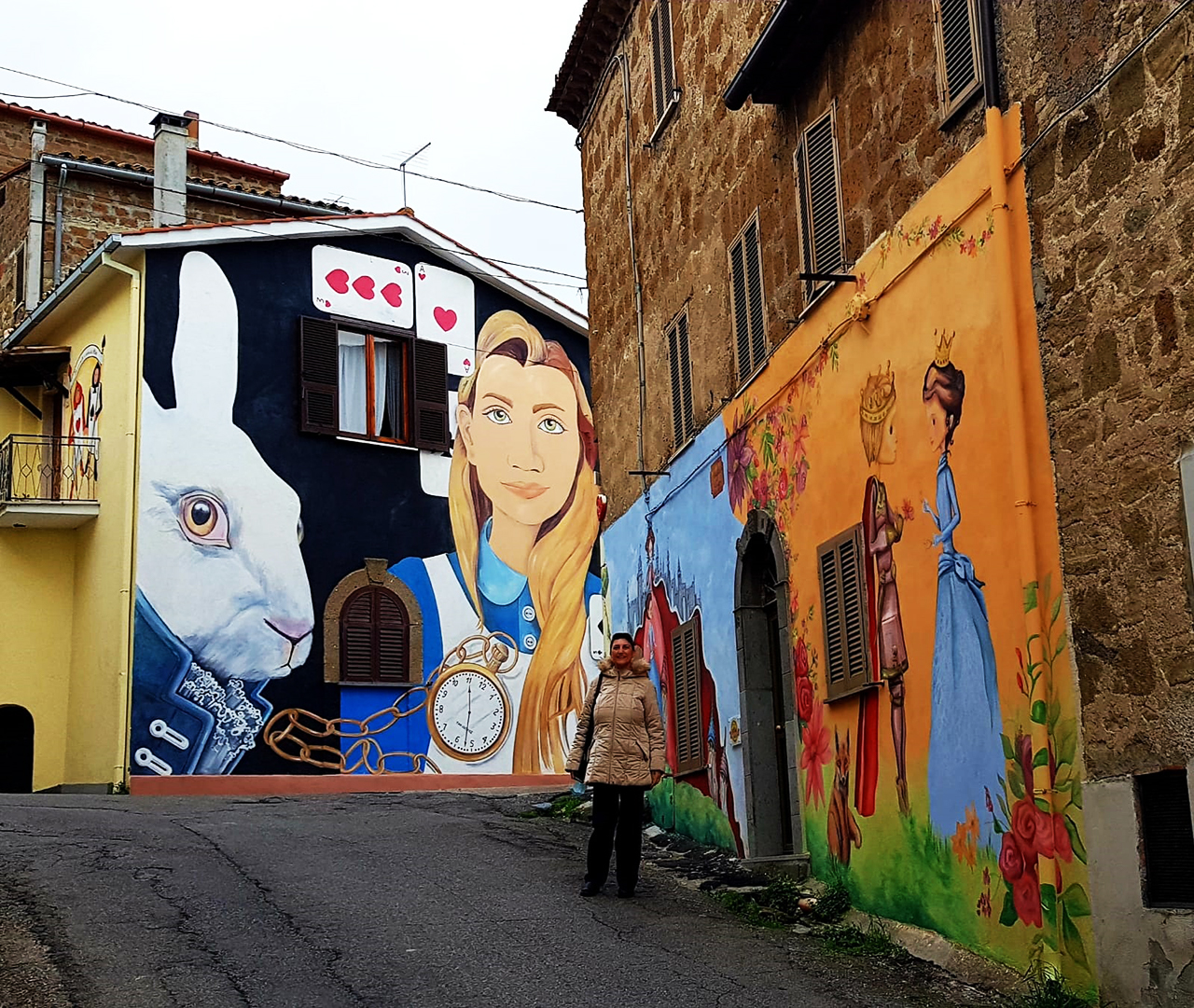
Art saves the world and the small Italian villages
Settled on the rocks of a mountain. Hidden in the dense vegetation of a forest. Perched on top of a cliff. Small, ancient and semi-deserted: Italy is dotted with almost abandoned villages that are disappearing; they have been abandoned for centuries because afflicted by earthquakes, hunger or simply by the lure of the city life. Suspended in time, inhabited by a few souls but still full of charm, history and art, they have been given new life thanks to artists, intellectuals or professionals who have recovered the building heritage. Once restored or painted and decorated, villages and outskirts have more and more frequently acquired fame and found a new splendour, attracting tourists from all over the world.
Walking in these villages relaxes and satisfies the curiosity and desire for culture, local traditions and slow life.
Each place invokes history, houses a quiet atmosphere and is the ideal destination for those who love art, local gastronomy and the legacy of the past. Italy’s villages and peripheral realities conquered by the phenomenon of street art are becoming more frequent. It is a highly effective tool in the regeneration and rebirth of “marginal” areas of the country.
In this article, we are going to discover 10 places not to be missed in Lazio.
Acquapendente: between history and street art
Here, Street Art had great international artists as protagonists who filled the historic centre with creativity. The murals have become part of the urban landscape and, finding them, is like a treasure hunt: some are inside courtyards and in almost hidden alleys and others are more evident. A walk through the streets and alleys of the town will allow you to appreciate these works, without forgetting the history of the place that hosts them.
Acquapendente is not just a village on the ancient Via Francigena but also an important place of devotion and a spiritual destination. The oldest copy of the Sacellum of the Holy Sepulcher is preserved in the Romanesque crypt of the Cathedral. In its interior there are relics – stones soaked in the blood of Jesus – brought by the Christian knights of Acquapendente who had participated in the First Crusade. Acquapendente is also a place of enchanted woods, clear flowing waters, and other itineraries to the discovery of rich biodiversity and surprising landscapes. That is why it is called the Green Jerusalem: a territory of the soul, an inner journey, a place to find oneself, a regenerating break along the path of life.
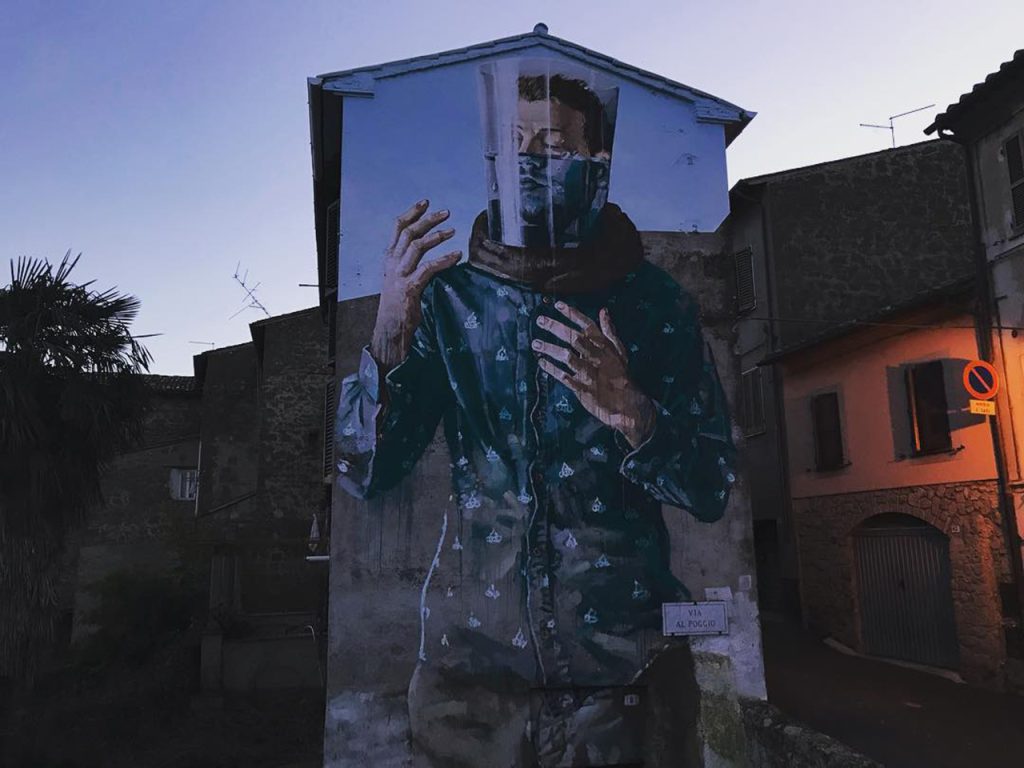
Calcata: the artists’ refuge
Calcata is a fairytale place just a stone’s throw from the Capital, surrounded by nature, populated by artists and drenched with spirituality where you can breathe a creative air. Perched on a rock overlooking the Treja Valley, like an island in an emerald sea, it fascinates the viewer and projects him into an indefinite era where the suggestions inspired by nature are added to those of a surreal story. Calcata is known as the “artists’ village” for the various painters, sculptors, musicians and even actors living here. On the square and in its winding streets which suddenly reveal breath-taking views, hidden under ivy-covered arches, curious artistic activities take place: furniture restoration, leather, ceramic and glass crafts, art studios, jewellery creations, cultural associations where you can listen to music, enjoy genuine sweets or read books.
It has even been described by the New York Times as one of the“trendiest villages in Italy”.
Calcata is a village that, in the Fascist period, risked disappearing due to a special law that required its demolition, given the instability of the tuff mountain on which it rests. With the threat of demolition, the village began to depopulate and most of the residents moved to nearby Calcata Nuova, a couple of kilometres away. In the seventies, it became a destination for artists and intellectuals, attracted by the magical atmosphere of the place, who took possession of the ancient buildings, transforming the town into a bohemian village. Many of these artists are Dutch, Belgian and American who bought old abandoned houses. They are not only painters and sculptors but also lovers of innovative technologies who have identified Calcata as a retreat where to open a shop, quickly transforming the village into an open-air academy.
From the “great door”, an opening in the walls of the ancient castle, we enter the city centre where houses and caves which are dug into the tuff overlap, including steep stairways, balconies with colourful flowers, narrow alleys and streets paved with large river pebbles. Some houses, most of which were formerly used as stables and barns, date back to 1200. Today, they house shops and colourful artisan workshops.
The real attraction of the place seems to be the positive energy emanating which has made this ancient village a place of harmony and balance for those who have had the sensitivity to feel it.
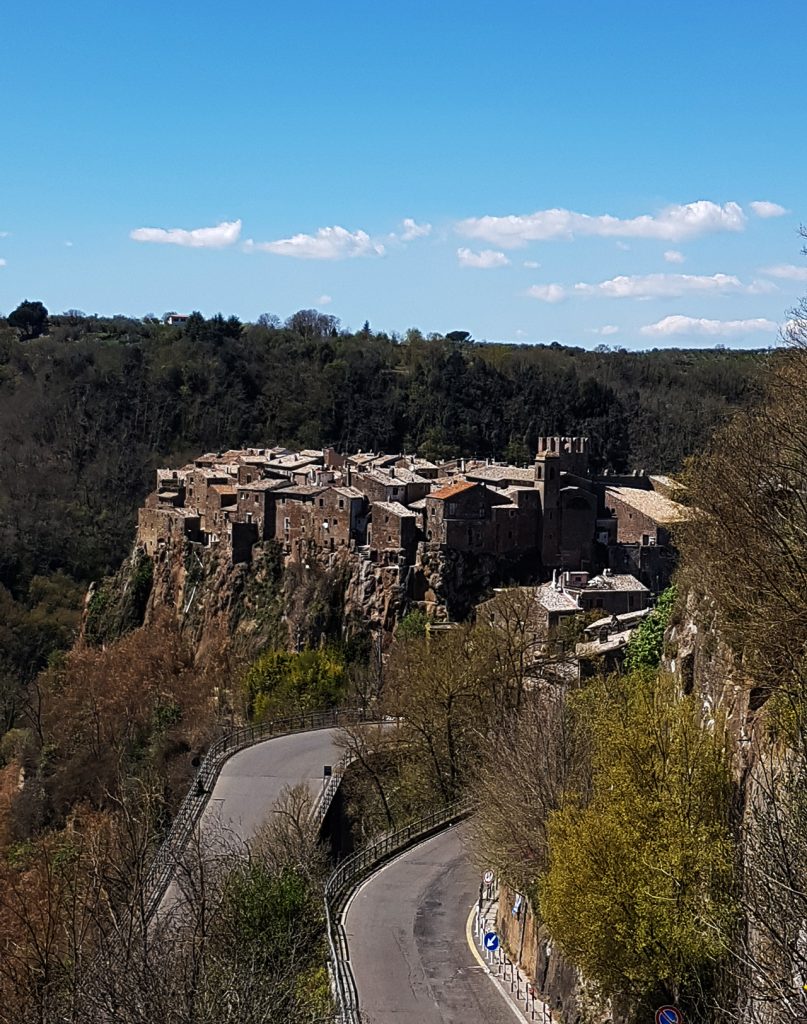
Cervara di Roma: the open-air museum
About seventy kilometres from the Capital, Cervara di Roma is a small town surrounded by green beech woods. The historic core preserves the original urban and architectural layout almost intact. The urban originality and the extraordinary features of the ancient village, are the setting of a breath-taking view of the Aniene valley that can be enjoyed from the main square.
What makes Cervara a destination not to be missed are not only its naturalistic landscapes of rare beauty but also its artistic heritage as numerous artists, including internationally renowned ones, have chosen it as a source of inspiration during the 19th and 20th centuries. Its characteristic staircase is scattered with murals, paintings and sculptures that appear between fifteenth-century houses and winding streets, indissolubly tying art to the stone on which Cervara stands. The Mountain sculpted by the Artists can rightly be defined as an open-air museum, because a lively walk full of murals and sculptures is entirely engraved in the rock.
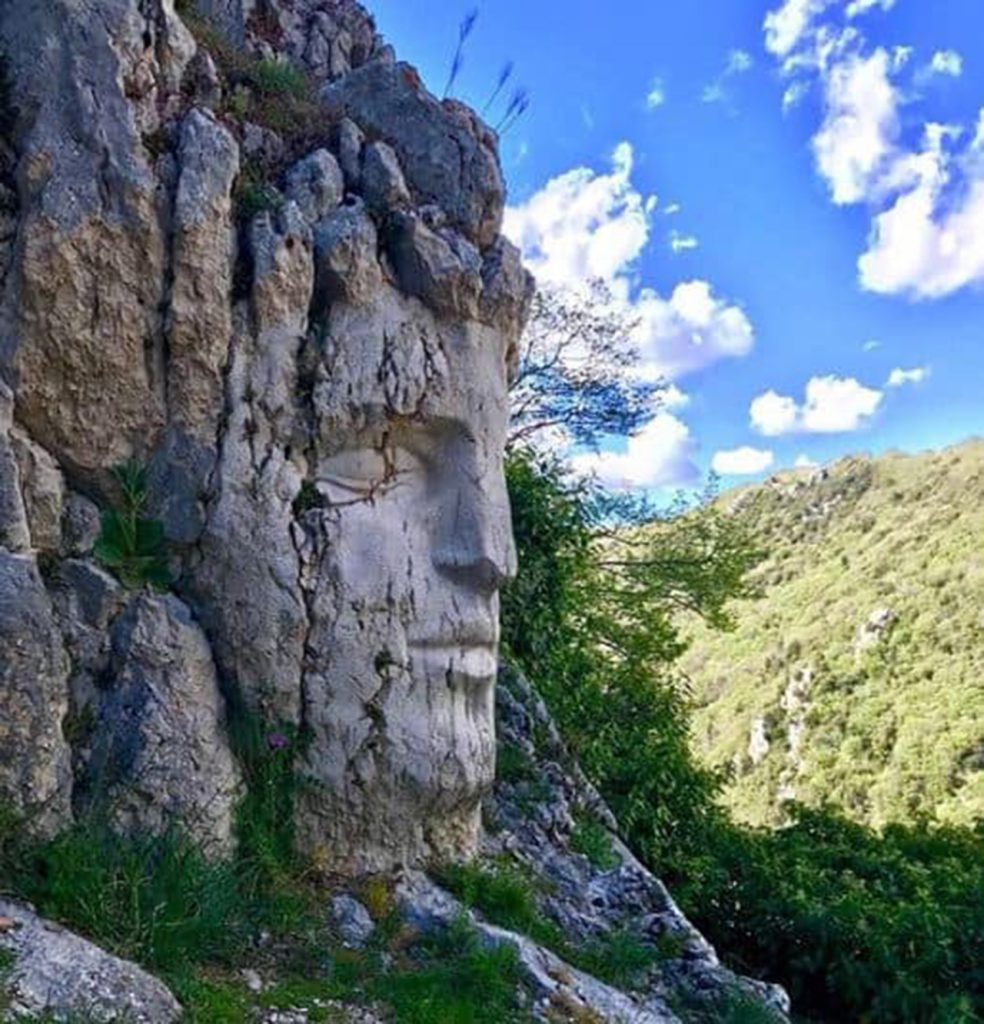
Civita di Bagnoregio: fragile beauty
Civita di Bagnoregio, in the far north of Lazio, is a jewel that the whole world envies us. Its beauty lies in its fragility. It has a very ancient history, dating back to about 2500 years ago. It was founded by the Etruscans along one of the most important communication routes between the Tiber and Lake Bolsena. It can be reached by crossing a long pedestrian bridge, because the town is located on top of a white tuff hill and floats in the middle of a valley like an island. Here, lies the uniqueness and charm of this Italian jewel.
For about two centuries, about twenty people have only inhabited it. The stone houses surround the cathedral, among flowered balconies, alleys and arches overlooking the valley.
Nicknamed by the writer Bonaventura Tecchi who was born there, “the dying city”, Civita di Bagnoregio risks disappearing because the tuffaceous hill that supports it is undermined at the base by the continuous erosion of two streams which flow into the valleys below and by the action of rain and wind.
The fate of the place, the taft of medieval houses, the very few families who still reside there and the unreal landscape of the clay gullies that besiege the village make Civita di Bagnoregio a unique and enchanting place.
Entering the narrow alleys leading off the square is like taking a trip back in time where, in an almost unreal silence, it is possible to enjoy graceful corners embellished with traces of past lives, flowers in the windows and sly sleeping cats. Ancient medieval palaces together with Renaissance oil mills and humble houses look at the immense surrounding gullies which, with their crests and their pinnacles, crown this small city, clinging to the life of its fragile clay hill.
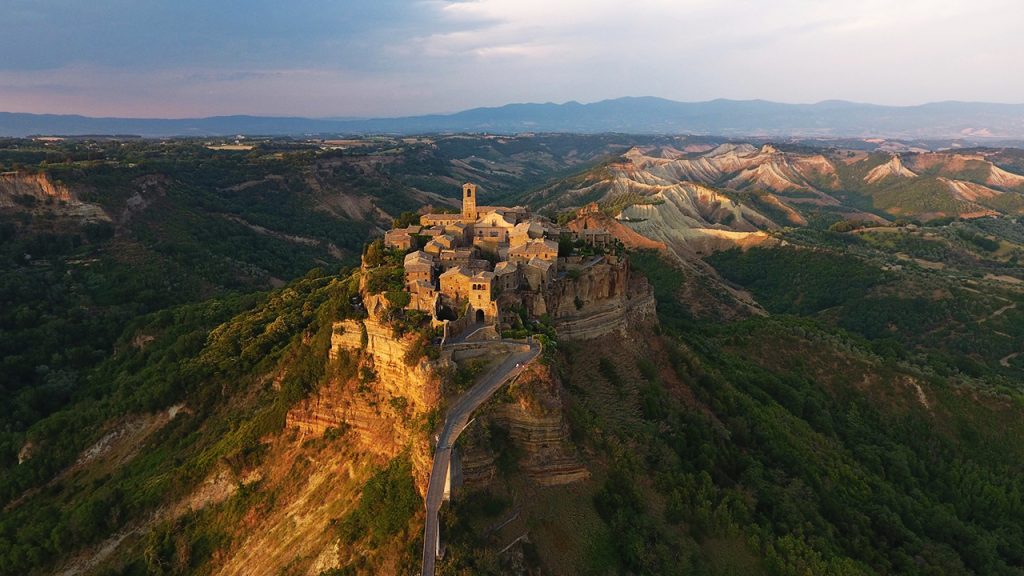
Greccio: street art at the service of Franciscanism
Greccio is, certainly, one of the most beautiful and picturesque places near Rieti that surprise, move and capture the visitor’s heart.
The ancient medieval village has an enchanting charm that recalls atmospheres of times gone by, while preserving intact its structure, typical of a fortified “castrum”.
It is a very special place, so much so that it was even able to steal St. Francis of Assisi heart who decided, together with Giovanni Velita, master of Greccio, to act here the first live nativity scene in the world to revive the birth of Jesus. In addition to its profound religious significance, Greccio can be considered to all intents and purposes a real pearl. Here, traditions and folklore mix together taking a step back in time and bringing to light ancient flavours.
Here, a path that from the Museum of Nativity disentangles through the streets, squares and alleys of the historic centre, offering visitors the opportunity to confront themselves with the 26 works, created by international artists on the walls of the old houses which express the spirit of Franciscanism in the world. An open-air contemporary art museum where Nature, Art and the Nativity scene are the main elements of its pictorial iconographic excursus.
Along the path it is possible to admire a commemorative shrine containing the boulder on which Francis of Assisi used to climb to preach to the people of Greccio.
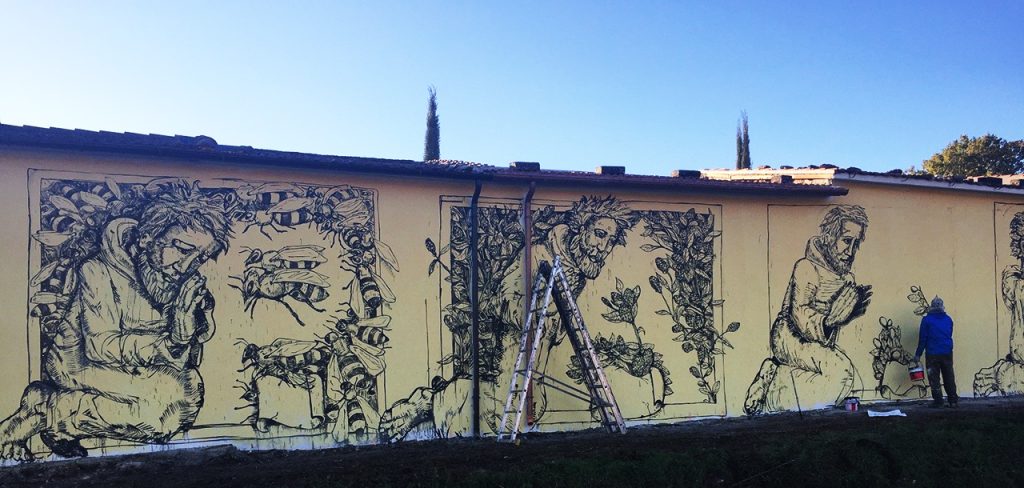
Labro: a medieval historical and architectural pearl
The millenary village of Labro lies, in a fan-shaped position, on a hill overlooking Lake Piediluco while the Terminillo mountain chain towers behind it.
Labro was the first village in Lazio to undergo to a conservative restoration. At the end of the 1960s the Belgian architect Ivan Van Mossevelde who undertook a daring urban recovery work, discovered the ancient town almost completely depopulated due to its poor accessibility to cars. In those same years in which the historical nuclei of many cities and towns of Italy were destroyed by modernization, in Labro the use of materials and, above all, of original forms managed to regain the authentic atmosphere of the medieval fortress and bringing it back to life. Thanks to a wise and loving recovery, today the village continues to shine for its uniqueness, uniformity and architectural homogeneity.
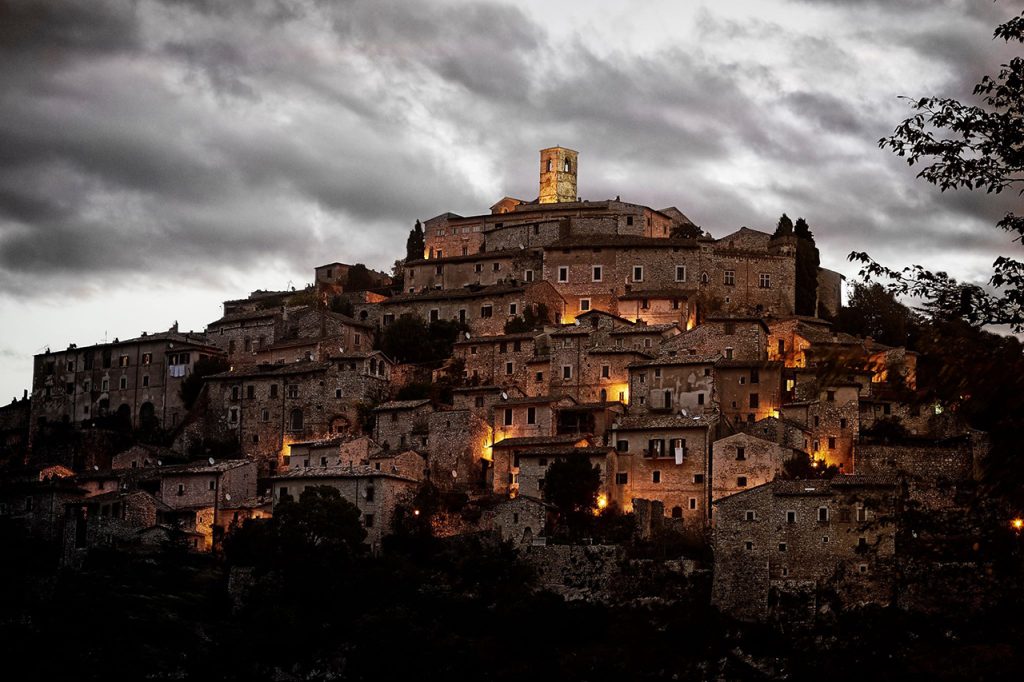
Sant’Angelo di Roccalvecce: the town of painted fairy tales
Surrounded by the splendid landscape of Viterbo, is a tiny village that, in recent years, has been proof of how imagination and resourcefulness can add value to what is about to be forgotten.
We are talking about Sant’Angelo di Roccalvecce, a small hamlet of Viterbo, a rediscovered gem of the area in which an artistic project aims to revive the best-known fairy tales and an integral part of the history of all of us to valorise this corner of Tuscia.
Like many other villages, it risked becoming a “ghost village” due to depopulation. An ambitious redevelopment project has given the town new life and a new look. The first mural, depicting the fairy tale of Alice in Wonderland, was inaugurated in November 2017.
Since that day, installations and mosaics have coloured the walls of the town with drawings dedicated to the world of fairy tales and legends, the number of murals has multiplied to 36 scattered in every street and corner of the town. Sant’Angelo is known as “the town of fairy tales” as the paintings that brighten its streets depict the characters of the most beautiful fairy tales. Among these are “The Jungle Book”, “The Sword in the Stone” and many others.
Thanks to this project, which includes the creation of 100 works within six years, the village has slowly come back to life.
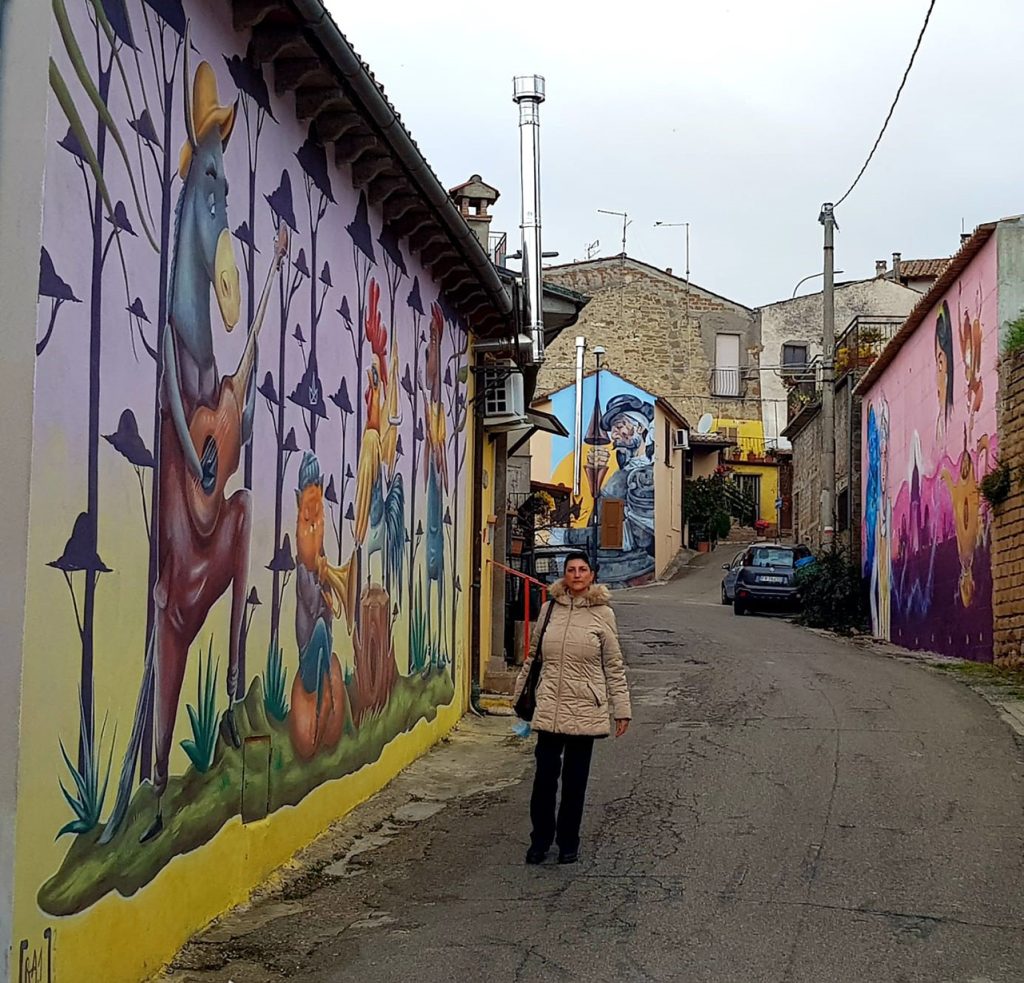
Garden of Ninfa: gardening as an art and as a philosophy
A few kilometres away from Sermoneta, enclosed between the Lepini Mountains and the Agro Pontino, lies located the Garden of Ninfa, an enchanted kingdom, born on the remains of the ancient city of Ninfa, whose name derives from a Roman temple dedicated to the Naiadi Nymphs, the divinities of spring waters.
Sacked and destroyed in 1382, the city of Ninfa was no longer rebuilt also due to malaria that infested the nearby plain. The few remaining inhabitants left, leaving behind the ruins of a ghost town.
In the 16th century, Cardinal Nicolò III Caetani, owner of the fief and a lover of botany, began to build a “garden of delights” in the area of the vanished medieval town of Ninfa. However, it was not until 1921 that, Gelesio Caetani began the recovery of the area, creating a true Anglo-Saxon-style garden, reclaiming the marshes, planting cypresses, holm oaks, beeches, and restoring some of the ruins. Guided above all by sensitivity and sentiment, following a free, spontaneous and informal direction, without a cut and established geometry, Gelesio began to plant various botanical species that he brought from his travels abroad and which grew well in Ninfa thanks to the favourable and very humid climate, provided by the river Ninfa and the cliff of Norma.
Defined by many as the most beautiful in the world, this romantic English garden , covers in all 8 hectares of greenery and contains over 1300 different species of plants from all over the world, from Japanese maples to magnolias, from irises to many species of rare roses, as well as exotic and tropical plants. It is an enchanting alchemy between ruins and ancient botany: today there are the remains of churches, towers, mills and houses connected by wooden bridges over ice and emerald-coloured streams along with bamboo groves, colourful rose gardens, blackthorns, Japanese maples, silver-leaf pines, fog trees, lavender avenues, hanging cherry trees, tulips and wisteria, papyrus and star magnolias. Such an enchantment has always been a source of inspiration. In fact, in the 1930s Marguerite Chapin, wife of Roffredo Caetani, opened the doors of the garden to the circle of writers and artists linked to the magazines she founded. For instance, the prestigious “Botteghe Oscure” that collected works by young authors, unknown at the time: Truman Capote, Dylan Thomas, Muriel Spark, Camus, Caproni, Gadda, Moravia, Calvino and Pasolini.
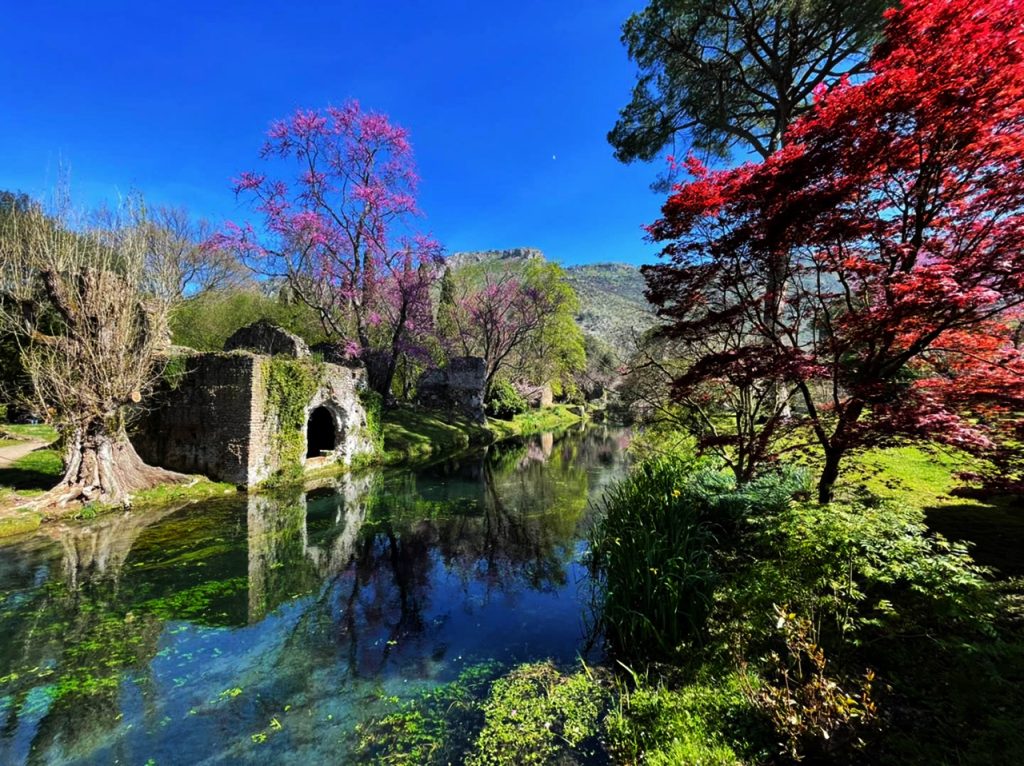
Rivodutri: a small paradise of contemporary art
The village of Rivodutri is a small town of only 1000 inhabitants which has always been a particularly loved place for all those who enjoy moments of reflection in contact with nature. Not for nothing, St. Francis himself chose the town during his pilgrimages. Visiting this village is a bit like taking a step back in time, living in a world where time seems to have stopped. The town, in fact, largely retains its ancient appearance with buildings from the fifteenth and sixteenth centuries. There is also a surprising and enigmatic monument in the village, which confirms how, in every age, the beauty and solitude of these places have encouraged some particularly sensitive and wise people to question about the fate and deep nature of human beings. This is the Alchemical Door, a solitary arch decorated with strange sculptures and inscriptions. It stands in front of a small garden, completely unrelated to the surrounding buildings. Installed there in recent times, it is one of the few artistic elements of Rivodutri that survived the earthquake of the 31 of December 1948. An earthquake that devastated the town causing the collapse of the ancient houses, including the building on which the unique portal was set.
Starting in 2012, to put the spotlight on this small village, the administration launched a project that includes temporary events and an open-air path of permanent works distributed throughout the various hamlets of the territory. A widespread museum that belongs to the community and visitors.
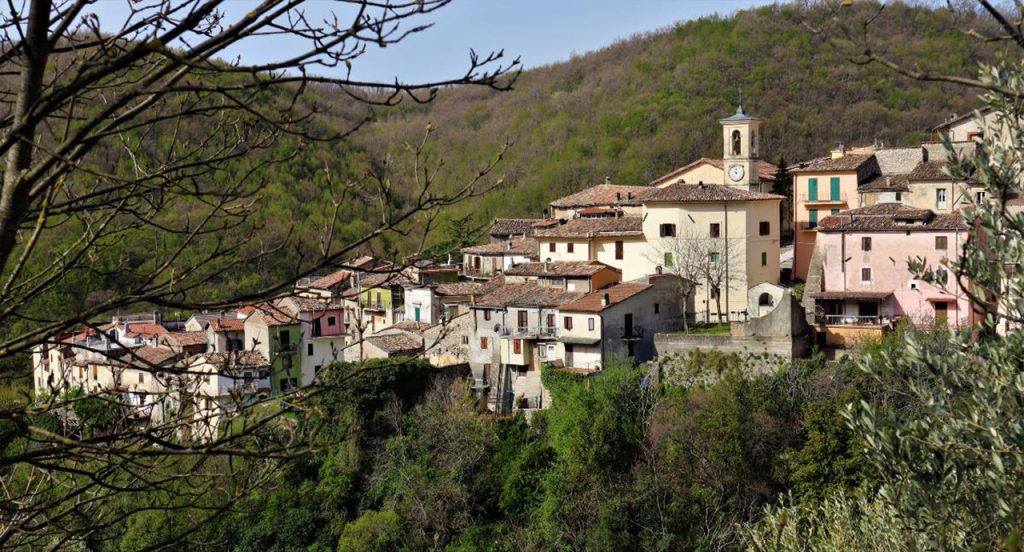
Rocca di Papa: open air art a few steps from Rome
Perched at 700 meters above sea level and with its characteristic, coloured houses and the wonderful panorama that can be admired from the top of the town, the village is certainly the ideal destination for a walk in the Castelli Romani, if you love to wander through quiet decorated alleys, here and there, with murals and street art installations. A fascinating village to be discovered or rediscovered but also a place with centuries of history, art and sacred tradition.
Here, in the 1980s, the local painter Miro Fondi began to decorate the alleys of the historic centre with the creation of some murals In the following years, art masters and friends of the painter Miro who loved art and desirous to give their own contribution to the spread of this more immediate and popular form of communication, contributed through the creation of colourful permanent paintings.
